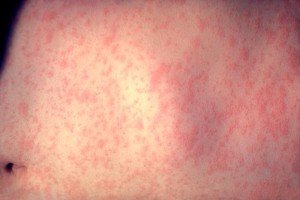Measles was a real battle in the Philippines in 2014 with the final measles tally on the archipelago at 58,010 cases, according to the World Health Organization (WHO). This includes 110 people who lost their lives to this very contagious virus.

Image/CDC
This represented a nine-fold increase in cases in the Philippines compared to 2013, when the total cases were 6,497 and 26 deaths.
The measles outbreak prompted Philippines health officials to institute a mass vaccination campaign last fall, Ligtas sa Tigdas, in an effort to get the outbreak under control.
Measles exported from the Philippines has been linked to outbreaks in several countries to include the United States, Canada and others. An outbreak in Ohio last year that affected hundreds began with unvaccinated Amish travelers to the Philippines
Some suspect that the Philippines may be the source of the Disneyland outbreak that started in California. The source of the initial Disney theme park exposure has not been identified; however, specimens from 30 California patients were genotyped; all were measles genotype B3, which has caused a large outbreak recently in the Philippines, but has also been detected in at least 14 countries and at least six U.S. states in the last 6 months.
Related: The cost of measles: Let’s look at Utah
The Centers for Disease Control and Prevention (CDC) recommends that travelers to the Philippines protect themselves by making sure they are vaccinated against measles, particularly infants 6–11 months of age (1 dose of measles vaccine) and children 12 months of age or older (2 doses of measles vaccine). Clinicians should keep measles in mind when treating patients with fever and rash, especially if the patient has recently traveled internationally.
Related: WHO on MERS in the Philippines



6 thoughts on “Philippines measles outbreak 2014: 58,010 cases, 110 deaths”